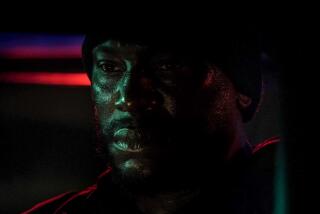‘The Fast and the Furious’ Is Lame Yet Lively
- Share via
Just when we thought we couldn’t choke down another teen exploitation movie, along comes Universal’s “The Fast and the Furious.”
By Hollywood standards, the film, directed by Rob Cohen, embodies all the juicy ingredients of car-cult movies before it--fast cars, faster women and lots of racing.
“Rebel Without a Cause,” “Grand Prix” and “LeMans” all scored big at the box office and went on to become classics.
“Fast” certainly scored big at the box office in its opening weekend--an estimated $41.6 million in its first-place finish. But does it have the ingredients to push it into classic status?
As full-length features go, “The Fast and the Furious” is more flash than substance.
There are some familiar faces, recognizable race cars were used for the most part, and the action scenes were entertaining, to a degree. But “The Fast and the Furious” is no “American Graffiti,” and it makes too many mistakes to be anything but a B-movie.
Defenders say, “Well, that’s Hollywood.”
But for anyone who lives, breathes and sleeps today’s car culture, Cohen’s film is essentially an hour and 45 minutes of Rebel Without a Clue.
Worse, it is aimed directly at an impressionable youth market and glamorizes street racing without making it all that clear that such activities are illegal and dangerous--to the racers and to innocent motorists in the vicinity.
Set in Los Angeles, “The Fast and the Furious” is an exploitation film about hot-rodded imports driven by street thugs who rule the road by intimidation, all set to a backdrop of gritty rap music.
Latinos are portrayed as thick-accented gang-bangers, African Americans as devilish and Asians as swarthy gangsters--all images that ignore the racial melting pot the compact-car scene has become.
To retain a sense of realism, Cohen relied on the import street racing community, and found enthusiast Craig Lieberman, race director for the Los Angeles-based National Import Racing Assn., more than willing to consult for the film.
Either Lieberman was simply overwhelmed by the demands of Hollywood or Cohen chose to take liberal amounts of artistic freedom in applying his consultant’s advice.
“I agree that some things weren’t too realistic,” Lieberman says. “We didn’t get to use a bunch of Nissan Skylines (ultra-high-performance cars imported from Japan for die-hard enthusiasts) and had to go with a cross-section of [more common] cars like [Toyota] Supras and [Honda] Civics.”
On the plus side, he says, “They mixed the people up real well. Most of the extras were real people in the industry . . . [and] they were able to [replicate] the sounds of the race cars more than other car movies.”
The film attempts to redeem itself with stunt-driving sequences that are on par with those in films such as “Gone in 60 Seconds.” But bad dialogue and a sketchy plot only go so far.
One of the more ridiculous moments comes when undercover cop Brian O’Conner (the good guy, played by Paul Walker), driving a nitrous-powered Mitsubishi Eclipse, street-races gang leader Dominic Toretto’s Toyota Supra. O’Conner and Toretto (Vin Diesel) roar up the middle of an unnamed Los Angeles boulevard late at night--as hundreds of fellow street racers block the road.
In a scene out of TV’s “Night Rider,” where the “turbo boost” button was king, O’Conner pushes the nitrous injection button on the steering wheel of his Eclipse for more engine power. His head slams into the back of the seat--as if he’s being catapulted from the deck of an aircraft carrier--and huge flames shoot from the exhaust pipes. Neither thing happens in real racing.
Just as you think “Wait, this can’t get any sillier,” the engine explodes and the car begins to disintegrate as it rolls to a raucous stop.
You know the car is toast at this point, but Cohen apparently didn’t, as seconds later, O’Conner fires it up and drives away as if nothing had happened.
Quick, dial 911.
More to Read
Only good movies
Get the Indie Focus newsletter, Mark Olsen's weekly guide to the world of cinema.
You may occasionally receive promotional content from the Los Angeles Times.









